Sutton Girls Grammar School
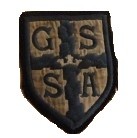
The Grammar School Badge
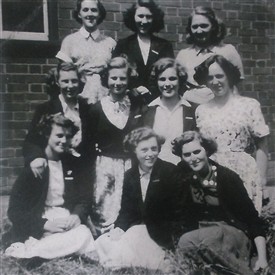
Lower VI 1951
courtesy Averil Higginson
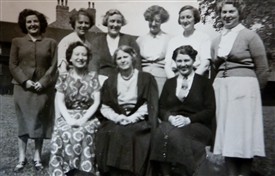
Staff at the school in 1957
courtesy Betty Draper
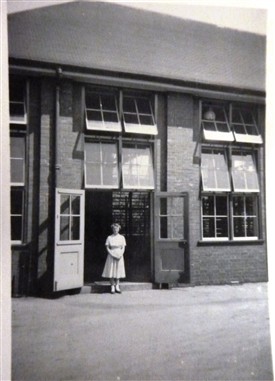
the gym
courtesy Betty Draper
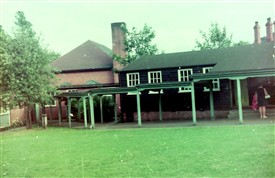
The covered walkway
courtesy Averil Higginson
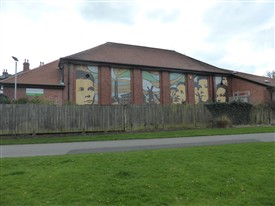
The old gym-still used today
By Marg Thorne
The Fisher Act, had an impact on education. Looking at educating children became a priority for all areas. It was found that there was a shortage of teachers, which was compounded by WW1 when some teachers went to war. Prospective teachers needed to be better educated as a result of the leaving age being raised to 14. In consequence, the Education Committee decided to establish two centres, one in West Bridgford and the other in Sutton in Ashfield. The Sutton centre would utilise part of the Upper Standard School on Station Road. Work began in 1918.
Fifteen children were enrolled at the preliminary classes using just one room of the school. By 1920 there were 53 pupils, all of whom were girls. Forty-four had won scholarships. By 1921, there were seventy one pupils, fifty-six were between the ages of 11 and 16, and fifteen between 16 and 18. It was impossible to carry on using the Upper Standard School due to the lack of space, so the committee decided to buy Lawn House and two acres of land.
The Council bought the property known as Lawn House, complete with stables and outbuildings from Benjamin Walton for £3000 in May 1921. It had previously been owned by The Unwins. William Oates lived there in 1891. Oates was the land agent for the Unwins calling himself an "agent and a farmer of 146 acres of land", living on Forest Street. In 1904, John Douglas Fidler, solicitor, was in residence. It was later acquired by Benjamin Walton of Stoney Street.
July 1921 saw the School managers as being Rev J. Stephenson; Mrs W. Burn; Dr F.D. Martin; Rev A.T. Cowen; Mr A.H. Bonser; Mr G.G Bonser; Mr A. Broomhead, and Mr F. Nowell. At this time, the Board of Education hadn't sanctioned the use of the building but had proposed that the four downstairs rooms were to be used as a medical clinic. Three bedrooms and one sitting room upstairs were for lodging accommodation for the staff at the pupil teacher centre. One upstairs room was to be used for a bedroom for the resident nurse. The kitchen, scullery etc and rooms in the house which were being lived in were to be a housewifery centre. Stables, coach house etc were to be let, probably for garage purposes but used if necessary for a cookery or woodwork centre, or whatever was needed. Two rooms were to be set aside for use on two afternoons a week which would be rented by the child welfare centre.
In effect, the ground floor rooms formed an agreement with Sutton Urban District Council for a Child Welfare Centre. The committee decided to erect three temporary wooden buildings, providing three classrooms, one of which had apparatus for the teaching of science, and a cloakroom. The stables were converted into large rooms to be used as a dining room, library, music room, and for physical training. A harness room and outhouse was changed to a kitchen and larder. The centre was equipped to take 100 pupils.
Headmistress Miss J Parkin (previously principal Assistant Mistress at Hucknall Secondary School) together with two assistants were appointed.
The official opening for the centre was in June 1922. In 1923, the education committee purchased land on Kirkby Road for a secondary school. Until it was built in 1962, the land was used by the centre, and subsequently the grammar school for the purpose of PT.
Entry to the centre was by passing the “Intending Teacher’s Scholarship Examination." Originally the scholarship was only open to Sutton children, but because of demand the area was extended. In 1926, the Pupil Teacher Centre had it's first full inspection, the inspector's report being "most satisfactory". Following the report, additional accommodation for the instruction of five forms, saw a cloakroom and classroom being converted into two large classrooms. Additionally, a geography mistress was recruited. Another hut was put up in 1929. By 1930 there were 126 pupils who were able to take the Northern Universities School Certificate Examinations.
In 1932 the school was recognised as a secondary school (CSSS) under Miss Phyllis Sageman. The uniform for winter was a navy top coat; black velour hat with school band, gloves, navy gym tunic, regulation white blouse, regulation sweater or blazer, and black stockings. In addition for the summer, panama hat with school band, approved cotton dress and brown lisle stockings Rubber soled shoes with shorts and blouse were worn for physical training. This consisted of gymnastics, country dancing, netball, hockey, swimming, tennis and rounders. Showers were available and pupils supplied their own towels. Classes for flat feet and bad posture were also available. Pupils were asked for 1/- for summer, and the same for winter as a contribution to the games fund. Text books and notebooks were provided by the school. Pupils' progress reports were sent out termly. The studies consisted of scripture, English, history, geography, French, Latin, arithmetic, mathematics, general science, biology, art, needlework, cookery, craft, singing and music, which included piano lessons. Meals were charged at 9d per dinner, or 3/- per week. Girls taking their own lunches were asked for 1/- per term for the use of china.
Although maintained by Notts Education Committee, fees of £12 12s were charged per year. A second child was admitted for £11 0s 6d per year, although there were scholarships, or Governors' special places available. The school hours were 8.45 - 12.45 and 2.00 - 3.45. The school became a grammar in 1944/5, and was later under the guidance of Miss J I Adam.
Contracts were signed for the erection of a new gymnasium and covered walkway in May 1938, with the architect being E.W. Roberts, the contractors were Henry James (Mansfield) Ltd. Stone Masons were Gregory Brothers, The tilers were Singleton & Thurman. In 1939 it was completed, and walkways from Lawn House to the classrooms were in place. The cost being £4084. This consisted of £3200 for the gymnasium, £529 for the covered way, and fencing, paving, drainage etc £345. When completed, W. Allcock painted the gym area. For the build, Sherwood Colliery bricks (red) and Haunchwood (blue) bricks were used. The gym was covered with red asbestos roofing tiles, and original windows were casement. At the same time, three upstairs rooms in Lawn House used as a teachers’ hostel were converted into classrooms for 6th form use.
At the beginning of 1947, alterations to convert the Gas Cleansing Station into a classroom were done by Joseph Searson of Station Road Works. The cost was £560/10s. In 1948, it was decided to have a library, and one of the bedrooms was used.
The school hymn was "The Pilgrim Song" by John Bunyan, the music being composed by Thomas F. Dunhill. The school song was "The Pilgrim Way" (Stuart Young). Every year, the school had a speech day which was usually prior to the school holidays in July, although in 1968 it was in October. It celebrated the pupils' achievements during the year, handing out various cups, medals and certificates. This was in addition to the head teacher's speech, and the chairman's speech. There would also be music from the school choir or talented pupils.
The pupils used the tennis courts on the lawn during the summer months. Hockey seemed to be the main winter sport over at the land on Kirkby Road. The school buildings were always referred to as "temporary", and frequently plans for a new school was mooted. Two prefabs on Outram Street were used for needlework and cookery, and as an overflow classroom if needed. Classes were often seen walking to and from them across the lawn park, and into the school gate.
One of the achievements of the school in later years was at the Mansfield Music and Drama Festival where the school won the Dorothy Weddle Trophy, and the Miss S A Mason Cup. Prior to the closure of the school a record was produced, "Music from Sutton-in-Ashfield Girls Grammar School" directed by Joan Stafford Smith, accompanist Marjorie Thomas, which was recorded in the gym.
The school classrooms were mainly wooden huts surrounding a grass area. At the back of the grass area stood an air raid shelter. The final head teacher was Mrs R. W. Atkinson.
Sutton Grammar closed in 1970 with the majority of pupils moving to Quarrydale Comprehensive. The School itself was taken over by Eastbourne Secondary School, moving from further down Station Road.
In 1973 after Sutton Centre School opened, the area was used as an annexe for the centre.
From 1977 - 2008 it was taken over by the School Advisory Offices, after which it was used by Notts County Council Training Partnership for apprenticeship programmes and level 2 vocational training. The gym was used by the play service and as an archiving unit.
In 2013 the area was refurbished and redeveloped into a Young Peoples Centre continuing the use for the young people of Sutton.